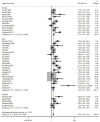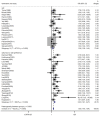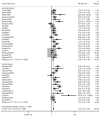Effect of Dietary Salt Intake on Risk of Gastric Cancer: A Systematic Review and Meta-Analysis of Case-Control Studies
- PMID: 36296944
- PMCID: PMC9609108
- DOI: 10.3390/nu14204260
Effect of Dietary Salt Intake on Risk of Gastric Cancer: A Systematic Review and Meta-Analysis of Case-Control Studies
Abstract
Aim: The effect of dietary salt intake on the risk of gastric cancer is not clear. A meta-analysis was performed to estimate the association between dietary salt intake and the risk of gastric cancer. Methods: Three major databases were searched to retrieve case-control studies published in English before 1 July 2022. Random effects model analysis was used to obtain the pooled odds ratios (ORs) and 95% confidence intervals (CIs) of the association between dietary salt intake and risk of gastric cancer. Subgroup analyses were used to identify possible sources of heterogeneity. Results: Thirty-eight case-control studies were included in this meta-analysis (total population: n = 37,225). The pooled ORs showed a significantly positive association between high salt intake and gastric cancer compared with low salt intake (OR = 1.55, 95% CI (1.45, 1.64); p < 0.001). In subgroup meta-analysis for geographic region, estimation method for dietary salt intake and the source of controls, this association was not changed. Conclusion: Higher dietary salt intake increased the risk of gastric cancer. This study has implications for the prevention of gastric cancer.
Keywords: case-control study; gastric cancer; meta-analysis; prevention; salt.
Conflict of interest statement
The authors declare no conflict of interest.
Figures





Similar articles
-
Effect of longer-term modest salt reduction on blood pressure.Cochrane Database Syst Rev. 2004;(3):CD004937. doi: 10.1002/14651858.CD004937. Cochrane Database Syst Rev. 2004. Update in: Cochrane Database Syst Rev. 2013 Apr 30;(4):CD004937. doi: 10.1002/14651858.CD004937.pub2. PMID: 15266549 Updated.
-
Replacing salt with low-sodium salt substitutes (LSSS) for cardiovascular health in adults, children and pregnant women.Cochrane Database Syst Rev. 2022 Aug 10;8(8):CD015207. doi: 10.1002/14651858.CD015207. Cochrane Database Syst Rev. 2022. PMID: 35944931 Free PMC article.
-
Selenium for preventing cancer.Cochrane Database Syst Rev. 2018 Jan 29;1(1):CD005195. doi: 10.1002/14651858.CD005195.pub4. Cochrane Database Syst Rev. 2018. PMID: 29376219 Free PMC article.
-
Dexrazoxane for preventing or reducing cardiotoxicity in adults and children with cancer receiving anthracyclines.Cochrane Database Syst Rev. 2022 Sep 27;9(9):CD014638. doi: 10.1002/14651858.CD014638.pub2. Cochrane Database Syst Rev. 2022. PMID: 36162822 Free PMC article.
-
Fortification of salt with iron and iodine versus fortification of salt with iodine alone for improving iron and iodine status.Cochrane Database Syst Rev. 2022 Apr 21;4(4):CD013463. doi: 10.1002/14651858.CD013463.pub2. Cochrane Database Syst Rev. 2022. PMID: 35446435 Free PMC article.
Cited by
-
Bile Acid Metabolism Analysis Provides Insights into Vascular Endothelial Injury in Salt-Sensitive Hypertensive Rats.Metabolites. 2024 Aug 16;14(8):452. doi: 10.3390/metabo14080452. Metabolites. 2024. PMID: 39195548 Free PMC article.
-
Recent advances in the role of high-salt diet in anti- and pro-cancer progression.Front Immunol. 2025 Jan 29;16:1542157. doi: 10.3389/fimmu.2025.1542157. eCollection 2025. Front Immunol. 2025. PMID: 39944693 Free PMC article. Review.
-
Racial/ethnic differences in risk factors for non-cardia gastric cancer: an analysis of the Multiethnic Cohort (MEC) Study.Cancer Causes Control. 2025 Mar;36(3):255-263. doi: 10.1007/s10552-024-01934-9. Epub 2024 Nov 7. Cancer Causes Control. 2025. PMID: 39509055 Free PMC article.
-
Exploring the link between dietary patterns and gastric adenocarcinoma in Brazil: a mediation analysis.BMC Med. 2024 Nov 28;22(1):562. doi: 10.1186/s12916-024-03785-2. BMC Med. 2024. PMID: 39609810 Free PMC article.
-
Single nucleotide polymorphism rs4961 in the adducin 1 gene is not associated with gastric cancer or preneoplastic cancer lesions.Oncol Lett. 2024 Jul 24;28(4):455. doi: 10.3892/ol.2024.14588. eCollection 2024 Oct. Oncol Lett. 2024. PMID: 39100993 Free PMC article.
References
-
- Mukkamalla S., Recio-Boiles A., Babiker H.M. Gastric Cancer. StatPearls Publishing; Treasure Island, FL, USA: 2022. - PubMed
-
- Azadnajafabad S., Ebrahimi N., Mohammadi E., Ghasemi E., Moghaddam S.S., Aminorroaya A., Rezaei N., Ghanbari A., Masinaei M., Fateh S.M., et al. Disparities and spatial variations of high salt intake in Iran: A subnational study of districts based on the small area estimation method. Public Health Nutr. 2021;24:6281–6291. doi: 10.1017/S1368980021002986. - DOI - PMC - PubMed
Publication types
MeSH terms
Substances
LinkOut - more resources
Full Text Sources
Medical

